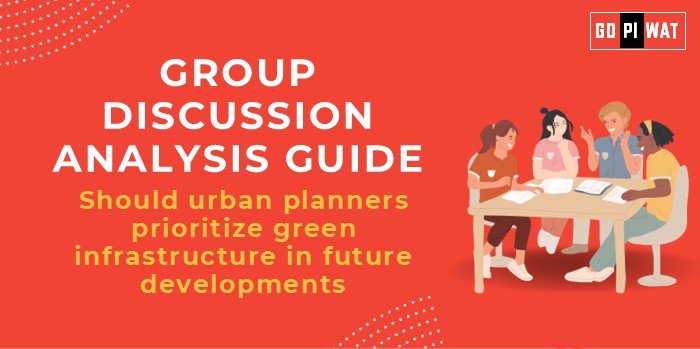🌱 Group Discussion (GD) Analysis Guide
Introduction to Green Infrastructure in Urban Planning
Opening Context: “As urban areas grow to house over 56% of the world’s population by 2050, the importance of sustainable urban planning has become undeniable. Green infrastructure offers a path to cities that are not just livable but also resilient to environmental challenges.”
Topic Background: Green infrastructure involves integrating natural elements like parks, green roofs, wetlands, and urban forests into urban planning. Emerging as a counterbalance to concrete jungles, this concept is gaining traction worldwide as a means to mitigate climate change, reduce urban heat islands, and manage water resources.
📊 Quick Facts and Key Statistics
- Urban Heat Island Effect: Cities can be 1-3°C hotter than rural areas due to extensive concrete coverage.
- Global Population Growth: By 2050, 70% of the global population will reside in urban areas (UN).
- Environmental Cost: Urban areas account for 70% of global CO2 emissions.
- Green Infrastructure ROI: Every $1 invested in green infrastructure saves $2-$4 in disaster management costs (World Bank).
🤝 Stakeholders and Their Roles
- Government and Policy Makers: Enacting regulations and incentivizing green developments.
- Urban Planners and Developers: Integrating sustainable solutions into designs.
- Citizens: Advocating for and maintaining green spaces.
- NGOs and International Organizations: Providing expertise and funding.
- Academia and Research Institutions: Studying impacts and developing innovative solutions.
🏆 Achievements and Challenges
🌟 Achievements
- New York City: Green roofs and urban forestry have reduced temperatures by 1.5°C in summer.
- Singapore: Vertical gardens and green rooftops cover over 50% of urban structures.
- India: Initiatives like Miyawaki forests have transformed barren lands in urban areas.
⚠️ Challenges
- High initial costs for green infrastructure projects.
- Space constraints in dense urban areas.
- Limited awareness among stakeholders.
🌍 Global Comparisons
- Success: Singapore’s extensive green infrastructure policies.
- Challenge: Struggles in implementing similar policies in cities like Cairo due to budget constraints.
📋 Structured Arguments for Discussion
- Supporting Stance: “Green infrastructure can mitigate urban flooding and improve air quality, enhancing residents’ health and reducing public health costs.”
- Opposing Stance: “High implementation costs and slow returns might deter cities with budget constraints from prioritizing green infrastructure.”
- Balanced Perspective: “While green infrastructure demands upfront investment, its long-term benefits in urban resilience and quality of life outweigh initial challenges.”
💡 Effective Discussion Approaches
- Opening Approaches:
- Data-Driven: “Urban areas, contributing 70% of CO2 emissions, require urgent green solutions to align with the Paris Agreement goals.”
- Contrast: “Singapore’s success story versus challenges faced by densely populated cities highlights the nuances of green urban planning.”
- Counter-Argument Handling:
- Acknowledge cost concerns but highlight cost-saving potential in disaster management and healthcare.
🔍 Strategic Analysis of Strengths and Weaknesses
- Strengths: Improves air quality, reduces flooding risks, enhances biodiversity.
- Weaknesses: High initial costs, limited awareness, requires ongoing maintenance.
- Opportunities: Expanding to developing cities, leveraging technology for cost-efficiency.
- Threats: Political will, climate emergencies outpacing urban planning efforts.
🎓 Connecting with B-School Applications
- Real-World Applications: Projects in urban sustainability, financial modeling for green infrastructure ROI, and urban operations research.
- Sample Interview Questions:
- “How can green infrastructure enhance urban resilience?”
- “What are the economic implications of investing in sustainable cities?”
- Insights for B-School Students: Consider urban planning as a case study for multi-disciplinary learning—finance, technology, and public policy.


